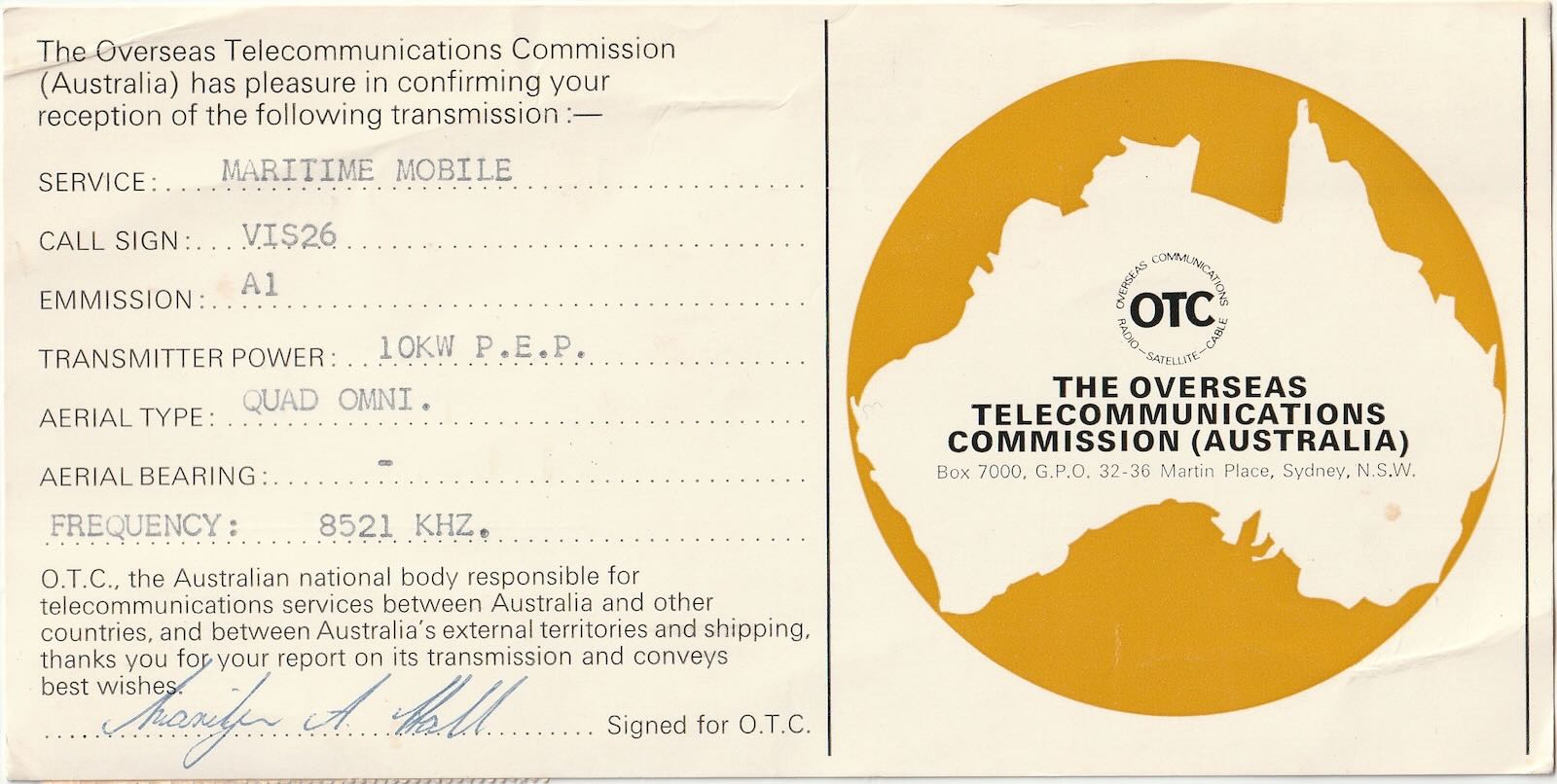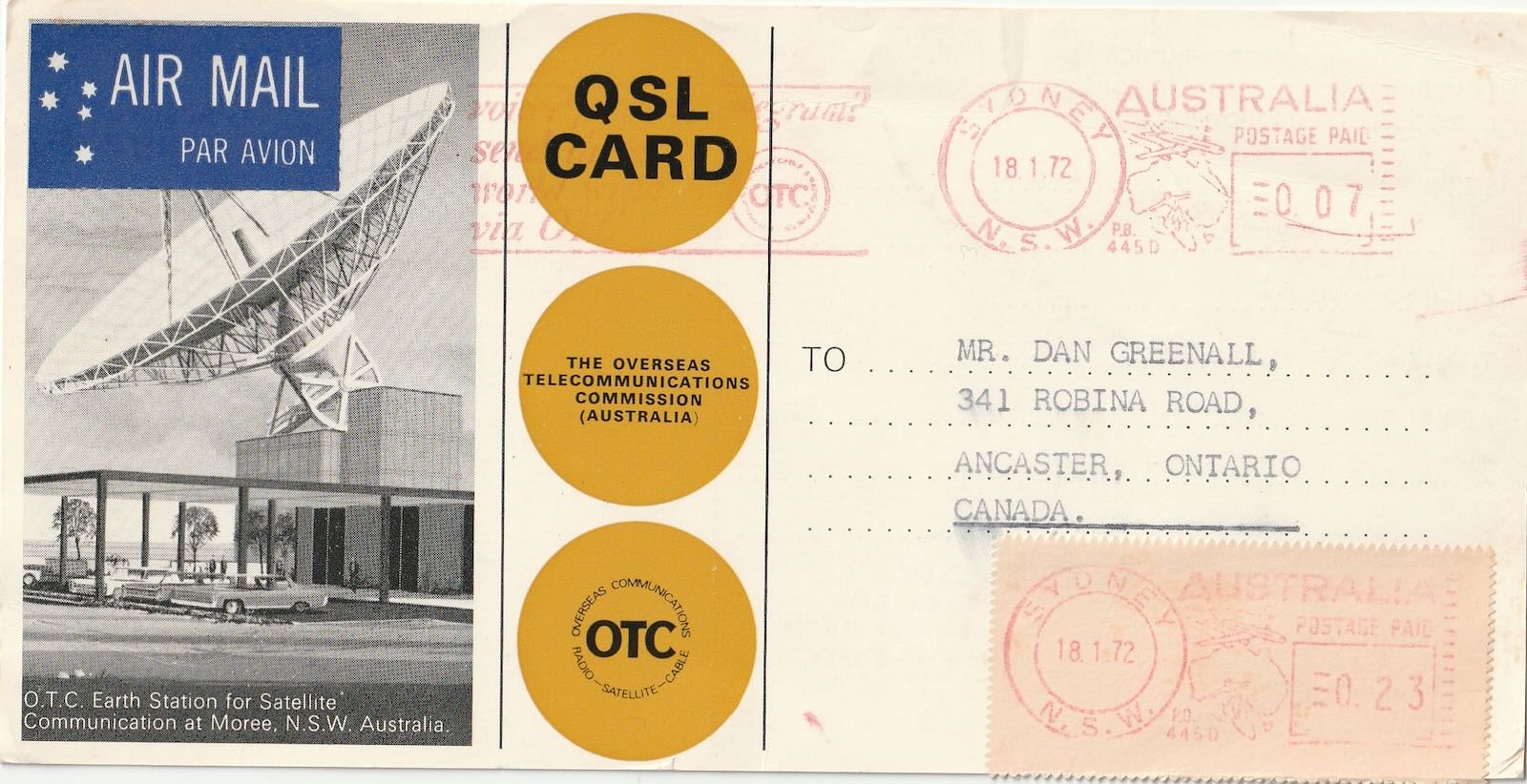Many thanks to SWLing Post and SRAA contributor, Dan Greenall, who shares the following guest post:
The End of an Era
by Dan Greenall
Many of us can remember the many radio telephone stations that could be found outside the regular SWBC bands during the 1970’s and 80’s and even into the 1990’s. They often ran repeating “voice mirrors” to help the receiving station tune them in prior to handling actual traffic. Some of these also operated within the designated maritime (ship to shore) frequencies.
One such station was coastal radio VIS from Sydney, Australia and they could frequently be heard here in southern Ontario, Canada on both SSB or CW modes. I received their attractive QSL card for reception in 1972.
However, with the advent of satellite and internet communications, these type of stations began to disappear from the HF shortwave bands.
On Christmas day in 1998, I happened to tune into the attached repeating transmission. This station is presumed to be maritime radio VIS in Sydney, Australia on 13083 kHz. The recording was made at Thamesford, Ontario, Canada on December 25, 1998. The repeating message was “The number you have called is not in service. Please check the number you have dialed. If you require further assistance, please call 1225.” 1225 was the number for International Directory Assistance in Australia.
Audio:
Internet research indicates that VIS discontinued its CW service in 1999. I believe the station completely closed down in 2002.



Sounds like you and I were on opposite ends of the stick. I was often control operator of AA4USA located at an undisclosed location outside of Atlanta Georgia. We operated daily with WAR and corresponded on RTTY with NMN. We had lots of Collins equipment and TMC all of which I was tasked with repairing and maintaining. So I know what you mean about a mechanic as well as an engineer. We also had AN/FRT-22 and the AN/FRT-79 As well as other Collins, TMC, and RF Harris equipment. I enjoyed working there. Some other location had Wilcox, and Bendix equipment. Taking about High Power HF Transmitters I once was on a site that had such a high power transmitter that Zippers and Buttons would vibrate to the voice peaks or CW notes. WB4IVG Laurin Cavender
As a young SWL with a Hallicrafters S-40A I would often hear the following: “This is a transmission for receiver adjustment purposes … [something about AT&T, I think] … This station is located near White Plains, New York”. I always wondered what kind of station that might have been. I don’t recall anything about frequency; I mostly listened to SWBC, but I was also fascinated with the “mysterious” goings on in the eight to nine MHz range.
I also grew up in southern Ontario. My first serious radio was a military surplus LW receiver, which also received the Tropical bands. I don’t remember anymore how I acquired it. Perhaps I found it in the trash. I had a lot of fun with it as a child. I definitely remember the many ship to shore transmitters heard, and the many stations which were transmitting for, “receiver adjustment purposes”. They were all over the LW band and the tropical bands back then (1960s to early 1970s). Alas, at some point, my “World War II tank radio” died and I disposed of it….perhaps at the same time that these transmissions mostly ceased!
“Utility” stations were one of my main interests when I began DXing in 1959. In addition to the Maritime stations, they were used for point-to-point international telephone traffic. (I have a letter QSL for the OTC link from Sydney to Oakland in 1960). In those days the bands were loaded with them and the identification tests loops were bountiful to show that propagation was still open between calls. Most of them used an archaic form of voice privacy that was originally designed for AM that simply inverted the voice (they called that “Condition A” – Condition “B’ was normal voice used for the voice loops). The funny thing was that by just flopping sidebands you could decode it!
My first job as an Engineer was on Harris 10kW ISB Transmitters (ISB is Independent Sideband – two simultaneous sidebands for two voice channels or one voice and one data). There was also a four ISB option.
When I transferred to Sales and Marketing I sold these transmitters to a number of customers in Asia for use in their point-to-point HF links. Malaysia was my biggest customer with, if I recall correctly, 16 transmitters and I also sold them to Cable and Wireless Hong Kong, Brunei, Burma and Nepal. Various Navies and AT&T Long Lines were also customers.
DXing these stations was lots of fun while they were around. Satellite and then fiber optic cables have completely replaced this technology!
Hey Bob, that certainly brings back some memories. I was a XMTR technician at WAR, (“This is radio station WAR talk testing for receiver alignment and station identification”,) NMF, and NMN, At WAR we had the big Collins AN/FRT-22s, and a couple of FRT-26s (same xmtr without the big amplifier bay and additional power supply to run the PAs) We also had some Western Electric 10KW whose exact nomenclature I don’t recall (but I have photos!) It was common to hear RCA/ATT talk testing on HF, I think from Manasquan NJ “Ocean Radio,” possibly using those Western Electrics.
We had a “beast” that was capable of 600 KW PEP – variable frequency. I believe at one time it was the most powerful variable frequency transmitter in existence. We were frequency agile but the receiver sites in Europe, Africa, and the Middle East seemed to favor 10.690 MHZ. Of course multi channel ISB. We had an open house one time for the local neighbors of the transmitter site and during the tour I put a patch up on speaker of a tone pack from the carrier (FDM) gear and stirred up a hornets nest. It seems that many members of the tour started complaining “that’s the sound I hear on my television, that’s the sound I hear on my FM radio! Well, a couple hundred KW on 10.690 might as well be exactly on the 10.7 IF on your average consumer electronics receiver! Oops!
Memories of days and equipment long gone.
At NMF and NMN we had Gates/Harris 10 KW (AN/FRT-79) and an assortment of smaller xmtrs (Wilcox). We were transitioning to Collins URG-2s when I left.
I also studied some TMC xmtrs in school but did not come in contact with them in the field/fleet. They were out there but not at any sites I worked at.
I also took a “busman’s holiday” and visited the WCC xmtr site.
Back in those days an HF Xmtr engineer/technician was as much a mechanic as a technician – servo motors, chain drives, couplings etc.
Bill- Wow. You got to work with some good stuff! And have some great stories!
I sure do remember WAR. I even have a non-verification letter from them in response to my report with QSL request.
The 10kW transmitter I worked on/sold were autotuned (about 15 seconds as I recall) and nomenclatured as FRT-84 for the Navy and the commercial versions were RF-745 with a special variant for AT&T called the RF-740M.